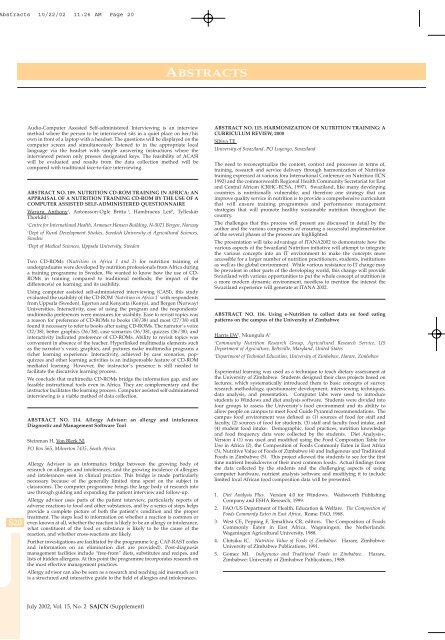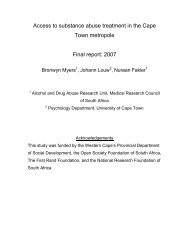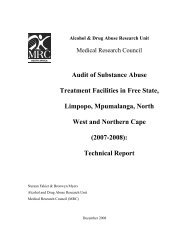Pan-African Conference 21 - 24 July 2002 Inter-Continental Hotel ...
Pan-African Conference 21 - 24 July 2002 Inter-Continental Hotel ...
Pan-African Conference 21 - 24 July 2002 Inter-Continental Hotel ...
You also want an ePaper? Increase the reach of your titles
YUMPU automatically turns print PDFs into web optimized ePapers that Google loves.
Abstracts 10/22/02 11:26 AM Page 20<br />
S20<br />
Audio-Computer Assisted Self-administered <strong>Inter</strong>viewing is an interview<br />
method where the person to be interviewed sits in a quiet place on her/his<br />
own in front of a laptop with a headset. The questions will be displayed on the<br />
computer screen and simultaneously listened to in the appropriate local<br />
language via the headset with simple answering instructions where the<br />
interviewed person only presses designated keys. The feasibility of ACASI<br />
will be evaluated and results from the data collection method will be<br />
compared with traditional face-to-face interviewing.<br />
ABSTRACT NO. 109. NUTRITION CD-ROM TRAINING IN AFRICA: AN<br />
APPRAISAL OF A NUTRITION TRAINING CD-ROM BY THE USE OF A<br />
COMPUTER ASSISTED SELF-ADMINISTERED QUESTIONNAIRE<br />
Waruru Anthony1 , Antonsson-Ogle Britta 2 , Hambraeus Leif3 , Tylleskär<br />
Thorkild1 .<br />
1Centre for <strong>Inter</strong>national Health, Armauer Hansen Building, N-50<strong>21</strong> Bergen, Norway<br />
2Dept of Rural Development Studies, Swedish University of Agricultural Sciences,<br />
Sweden<br />
3Dept of Medical Sciences, Uppsala University, Sweden<br />
Two CD-ROMs (Nutrition in Africa 1 and 2) for nutrition training of<br />
undergraduates were developed by nutrition professionals from Africa during<br />
a training programme in Sweden. We wanted to know how the use of CD-<br />
ROMs in training compared to traditional methods; the impact of the<br />
difference(s) on learning; and its usability.<br />
Using computer assisted self-administered interviewing (CASI), this study<br />
evaluated the usability of the CD-ROM ‘Nutrition in Africa 1’ with respondents<br />
from Uppsala (Sweden), Egerton and Kenyatta (Kenya), and Bergen (Norway)<br />
Universities. <strong>Inter</strong>activity, ease of using the program and the respondents’<br />
multimedia preferences were measures for usability. Ease to revisit topics was<br />
a reason for preference of CD-ROMs to books (30/38) and most (27/38) still<br />
found it necessary to refer to books after using CD-ROMs. The narrator’s voice<br />
(32/38), better graphics (36/38), case scenarios (36/38), quizzes (36/38), and<br />
interactivity indicated preference of CD-ROMs. Ability to revisit topics was<br />
convenient in absence of the teacher. Hyperlinked multimedia elements such<br />
as the narrator’s voice, graphics, and pictures make multimedia programs a<br />
richer learning experience. <strong>Inter</strong>activity, achieved by case scenarios, popquizzes<br />
and other learning activities is an indispensable feature of CD-ROM<br />
mediated learning. However, the instructor’s presence is still needed to<br />
facilitate the discursive learning process.<br />
We conclude that multimedia CD-ROMs bridge the information gap, and are<br />
feasible instructional tools even in Africa. They are complementary and the<br />
instructor facilitates the learning process. Computer assisted self-administered<br />
interviewing is a viable method of data collection.<br />
ABSTRACT NO. 114. Allergy Advisor: an allergy and intolerance<br />
Diagnostic and Management Software Tool<br />
Steinman H, Von Blerk Nl<br />
PO Box 565, Milnerton 7435, South Africa<br />
Allergy Advisor is an informatics bridge between the growing body of<br />
research on allergies and intolerances, and the growing incidence of allergies<br />
and intolerances seen in clinical practice. This bridge is made particularly<br />
necessary because of the generally limited time spent on the subject in<br />
classrooms. The computer programme brings the large body of research into<br />
use through guiding and expanding the patient interview and follow-up.<br />
Allergy advisor uses parts of the patient interview, particularly reports of<br />
adverse reactions to food and other substances, and by a series of steps helps<br />
provide a complete picture of both the patient’s condition and the proper<br />
treatment. The steps lead to information on whether a reaction is common or<br />
even known at all, whether the reaction is likely to be an allergy or intolerance,<br />
what constituent of the food or substance is likely to be the cause of the<br />
reaction, and whether cross-reactions are likely.<br />
Further investigations are facilitated by the programme (e.g. CAP-RAST codes<br />
and information on an elimination diet are provided). Post-diagnosis<br />
management facilities include “free-from” diets, substitutes and recipes, and<br />
lists of hidden allergens. At this point the programme incorporates research on<br />
the most effective management practices.<br />
Allergy advisor can also be seen as a research and teaching aid inasmuch as it<br />
is a structured and interactive guide to the field of allergies and intolerances.<br />
<strong>July</strong> <strong>2002</strong>, Vol. 15, No. 2 SAJCN (Supplement)<br />
ABSTRACTS<br />
ABSTRACT NO. 115. HARMONIZATION OF NUTRITION TRAINING: A<br />
CURRICULUM REVIEW, 2000<br />
Sibiya TE<br />
University of Swaziland, PO Luyengo, Swaziland<br />
The need to reconceptualize the content, context and processes in terms of,<br />
training, research and service delivery through harmonization of Nutrition<br />
training expressed at various fora <strong>Inter</strong>national <strong>Conference</strong> on Nutrition (ICN<br />
1992) and the commonwealth Regional Health Community Secretariat for East<br />
and Central <strong>African</strong> (CRHC-ECSA, 1997). Swaziland, like many developing<br />
countries is nutritionally vulnerable, and therefore one strategy that can<br />
improve quality service in nutrition is to provide a comprehensive curriculum<br />
that will ensure training programmes and performance management<br />
strategies that will promote healthy sustainable nutrition throughout the<br />
country.<br />
The challenges that this process will present are discussed in detail by the<br />
author and the various components of ensuring a successful implementation<br />
of the several phases of the process are highlighted.<br />
The presentation will take advantage of ITANA<strong>2002</strong> to demonstrate how the<br />
various aspects of the Swaziland Nutrition initiative will attempt to integrate<br />
the various concepts into an IT environment to make the concepts more<br />
accessible for a larger number of nutrition practitioners, students, institutions<br />
as well as the global environment. While various resistance to IT change may<br />
be prevalent in other parts of the developing world, this change will provide<br />
Swaziland with various opportunities to put the whole concept of nutrition in<br />
a more modern dynamic environment, needless to mention the interest the<br />
Swaziland experience will generate at ITANA <strong>2002</strong>.<br />
ABSTRACT NO. 116. Using e-Nutrition to collect data on food eating<br />
patterns on the campus of the University of Zimbabwe<br />
Harris EW 1 , Nkungula A 2<br />
1Community Nutrition Research Group, Agricultural Research Service, US<br />
Department of Agriculture, Beltsville, Maryland, United States<br />
2Department of Technical Education, University of Zimbabwe, Harare, Zimbabwe<br />
Experiential learning was used as a technique to teach dietary assessment at<br />
the University of Zimbabwe. Students designed their class projects based on<br />
lectures, which systematically introduced them to basic concepts of survey<br />
research methodology, questionnaire development, interviewing techniques,<br />
data analysis, and presentation. Computer labs were used to introduce<br />
students to Windows and diet analysis software. Students were divided into<br />
four groups to assess the University’s food environment and its ability to<br />
allow people on campus to meet Food Guide Pyramid recommendations. The<br />
campus food environment was defined as (1) sources of food for staff and<br />
faculty, (2) sources of food for students, (3) staff and faculty food intake, and<br />
(4) student food intake. Demographic, food practices, nutrition knowledge<br />
and food frequency data were collected by the students. Diet Analysis+,<br />
Version 4 (1) was used and modified using the Food Composition Table for<br />
Use in Africa (2), the Composition of Foods Commonly Eaten in East Africa<br />
(3), Nutritive Value of Foods of Zimbabwe (4) and Indigenous and Traditional<br />
Foods in Zimbabwe (5). This project allowed the students to see for the first<br />
time nutrient breakdowns of their most common foods. Actual findings from<br />
the data collected by the students and the challenging aspects of using<br />
computer hardware, nutrient analysis software and modifying it to include<br />
limited local <strong>African</strong> food composition data will be presented.<br />
1. Diet Analysis Plus. Version 4.0 for Windows. Wadsworth Publishing<br />
Company and ESHA Research, 1999.<br />
2. FAO/US Department of Health, Education & Welfare. The Composition of<br />
Foods Commonly Eaten in East Africa. Rome: FAO, 1968.<br />
3. West CE, Pepping F, Temalilwa CR, editors. The Composition of Foods<br />
Commonly Eaten in East Africa. Wageningen, the Netherlands:<br />
Wageningen Agricultural University, 1988.<br />
4. Chitsiku IC. Nutritive Value of Foods of Zimbabwe. Harare, Zimbabwe:<br />
University of Zimbabwe Publications, 1991.<br />
5. Gomez MI. Indigenous and Traditional Foods in Zimbabwe. Harare,<br />
Zimbabwe: University of Zimbabwe Publications, 1989.

















